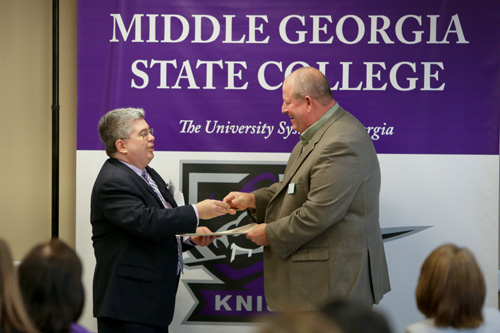Dublin Campus Fills Vital Role for Middle Georgia State
Author: News Bureau
Posted: Friday, May 17, 2013 1:45 PM
Category:
Pressroom
Macon, GA

He was nearly 30 when finally he was able to enroll at the Dublin Campus of what is now Middle Georgia State College, where today he is thriving as a student leader and member of the Phi Theta Kappa honor society.
“I’m grateful there was a campus where I live so I could start college,” said Jones, now 32, a psychology major whose goal is to earn a doctorate and become a therapist working with troubled teens.
“The Dublin Campus is convenient and has a good reputation. It’s not overwhelming, which is good for people like me who were out of school for a while.”
About 700 students attend the Dublin Campus, which has served Laurens County and the surrounding area for nearly three decades.
Partly located in a former hospital that Laurens County donated to the University System of Georgia, which renovated the space into classrooms, it could be the only campus anyplace where faculty and staff occasionally hear students say “I was born here” and know they mean it literally.
“We also have a morgue,” said the campus’s affable director, Dr. Stephen Svonavec. “We use it for storage.”
Laurens County, about an hour southeast of Macon, is the site of a major VA hospital and a regional hub for distribution centers. A recent Telegraph article noted that two large companies, Dinex, a Danish manufacturer of automotive exhaust and emission systems, and another vehicle supplier, Germany-based Erdrich Umformtechnic GmbH & Co., have major expansions underway in the county.
The economic growth potential along Interstate 16 is expected to continue, placing the Dublin Campus in a strategic position. Svonavec said Middle Georgia State is planning a needs assessment to see what bachelor’s degree programs it could offer in Dublin that are most in demand and would support area economic interests.
Currently, the Dublin Campus offers the University System’s core curriculum and about 20 associate’s degrees, including nursing.
“If we could offer a handful of bachelor’s degrees here, that would mean more students at this campus would stay at Middle Georgia State instead of transferring,” he said. “But, really, I think just being part of a larger consolidated institution is going to encourage more of our students to stay. Dublin may not get the specific bachelor’s degree a student wants, but there’s a great chance one of our other campuses will have it.”
The Dublin Campus originated in 1984 when it opened in a downtown location as a resident center of several University System schools, including the former Middle Georgia College. (The other schools are no longer involved.) The campus later moved to the renovated hospital building (known as the Dublin Building) on Kellam Road, near Carl Vinson Veterans Administration Medical Center.
Enrollment growth at the new location prompted the Board of Regents to fund the construction of a new building in 2000. That facility, which students and employees call the Library Building, serves as the campus’s main entrance.
A few years ago, the Veterans Administration donated to the Regents an old annex building and forty acres of land for the Dublin Campus’s use. Part of the annex is being renovated for the nursing degree program.
“We have plenty of room for future expansion,” Svonavec said.
The collection of new and renovated buildings has coalesced into a friendly feeling commuter campus that focuses on quality instruction (12 full-time and a number of part-time faculty are based on the Dublin Campus) while mixing in opportunities for students – about 70 percent of whom are traditional college age - to get involved outside the classroom.
Scotty Rainwater, the campus’s coordinator of student services, said a number of Dublin students, whom he affectionately calls “Dubsters,” are active in such organizations as the Multicultural Club and the Middle Georgia State Association of Nursing Students. The campus has a Student Government Association, which Rainwater advises. Recently, the SGA sponsored the 17th annual Battle of the Bands competition, part of Dublin’s St. Patrick’s Day Festival celebration.
“There is always something to do here, whether we are hosting a large event like Battle of the Bands or Spring Fling, or holding a collection drive for the Dublin-Laurens Humane Society,” Rainwater said. “For every daytime event we have, we try to have a corresponding evening event so our non-traditional students with families can participate. Being a commuter campus can pose difficulty for planning activities, but we have many students who really want to be involved.”
An associate professor of history who still teaches classes, Svonavec became director of the Dublin Campus in early 2012, right about the time the consolidation of the former Macon State and Middle Georgia colleges was announced. The merger, which became official in January 2013, remains a work in progress, but Svonavec believes the Dublin Campus will reap many short- and long-term benefits.
“This early after consolidation I’m not sure our students have noticed many differences on a day-to-day basis just yet,” he said, “but they will. Being part of Middle Georgia State College is a nice recruiting tool, and it’s going to give all of us – students, faculty, staff and the community – more opportunities.”
For more information about the Dublin Campus of Middle Georgia State College, visit www.mga.edu/about/campuses/dublin.aspx.
(This article originally appeared in the Spring 2013 issue of Middle Georgia State Today.)
